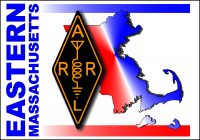I hope all are enjoying a nice summer, especially since the heat wave seems to have subsided. On August 7 a group of traffic handlers enjoyed good food and good conversation at the QTH of KW1U and K1WU in Concord MA. While 90+ degrees, we all managed to congregate under the big maple tree renewing old friendships and creating new ones. These friendships within the traffic handling community have been one of reasons I have enjoyed this hobby so much. We look forward to doing this again next year.
The next big event of the summer is the Northeast HamXposition on August 26-28 in Marlboro MA. For you traffic handlers and anyone else interested, there will be a “NTS Meet and Greet” on Saturday August 27 at 2:00 pm. We will hold this in conjunction with the New England Emergency and Public Service group headed by Cory Golob KU1U. Come meet with others involved in traffic handling and emergency communications and find out what has been going on in the various sections of New England and beyond.
Some might wonder what the different groups have to do with one another. Emergency groups such as ARES are generally local groups who prepare to assist in communications within a local community. NTS on the other hand is a national organization which has the facilities and expertise to move messages beyond that local area. Both can be vital in an emergency situation. And what emergency situations might we encounter in New England which doesn’t see much in the way of hurricanes, tornadoes, wildfires, earthquakes, etc.? What we are seeing are more and more threats to our infrastructure which is extremely dependent on the internet. There is good reason these days for all to be prepared. Come join an ARES net and help out in local situations but also join a traffic net to get the training, preparation and practice to be able to handle longer distance emergency communications when needed. Both are very much needed.
The QNI Newsletter published by WB8SIW, Chair of Radio Relay International, has been a good source of information on message handling and emergency communications. The latest edition (August 2022) has been published and can be found at www.qni-newsletter.net.
Traffic Tip of the month – some thoughts about use of the letter “X”. I quote from a recent email from W8YS, manager of Eastern Area Net Cycle 2 (that’s afternoon SSB):
“As I see and hear radiograms being passed everyday, it is apparent that there is much confusion about the use of the “X”.
This is from the NTS Methods and Practices Guidelines for phone ( not CW ) with my explanations added, for clarity.
1. An ‘X” may be used to separate parts of the text for clarity “if needed”. If not needed for clarity, don’t use it just to be using it.
2. The letter “X” is used as a substitute for a period (and is never used as the last group of the text). The “Break” will show the separation at the end of the text with no need for an “X”.
3. In English grammar your teacher taught you to put a period at the end of a sentence to separate sentences. This is NOT true in NTS traffic. Radiograms are designed for speed and efficiency. Radiograms are limited to 25 groups (or words, numbers). In a letter one can use as many words as he/she wants. Radiograms are meant to be more like telegrams – short and to the point. In telegrams you had to pay by the letter. In telegrams one would not waste his/her money for letters or words that were not necessary to convey the meaning or reason for the message. So do not waste the space of a group or word. You may need that space later in the radiogram for a necessary group. Radiograms are designed for speed and efficiency.
4. In radiograms do not use an “X” unless it is needed for clarity.
5. Rule of thumb – if you are in doubt about whether to use it or not, leave it out.
6. Do not use an “X” before “73” unless there is a figure group before the “73”. There is no reason to have an “X” in (example) “See you in September 73”. An example for using an “X” before 73 would be, “Take routes 48 and 40 X 73”. “Take Routes 48 and 40 73” would be confusing. The “X” would provide clarity.
7. The “X” is a separate group and IS counted for the check.
In conclusion, an “X” is used for separation and is never used as the last group of a text. An “X” is used for clarity. When in doubt, leave it out. An “X” is counted as a group for the check.”
73 to all and enjoy the rest of the summer. The Massachusetts STM report is available below.
Marcia KW1U
STM EMA / WMA

